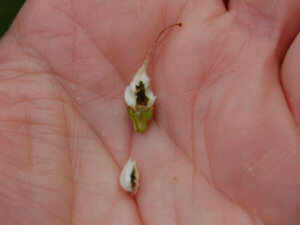Assessing Freeze Injury on Horticultural Plants – Yard & Garden News
Rosie Lerner and Bruce Bordelon, Purdue Extension Horticulture & Landscape Architecture
As so many gardeners are staying at home these days, we’ve had more opportunity to enjoy the spring display. And then, perhaps inevitably, “normal” spring frost and freeze visited. Some plants are vulnerable to damage. The amount of damage will depend on how far along they are in their development.
Home fruit-growers may have reason to be concerned: At 28 F, you can expect a 10 percent loss of flowers/young developing fruit. However, at 25 F that loss increases to 90 percent! Much of Indiana dropped to the mid 20s on the mornings of April 15 and 16.

Temperatures across the region the morning of April 16, 2020 (Midwest Climate Watch, Midwestern Regional Climate Center
For home growers, covering plants with sheets or blankets might provide a few degrees of protection.

Covering trees with sheets or blankets can provide a few degrees of protection. (John Obermeyer, Purdue Extension)
Bud counts were good until the freeze, so in some cases, even just 10 percent retained fruit might still be a decent crop on our tree fruits. Grapes may also still have ability to crop on shoots that have yet to emerge. Strawberries are a bit easier to protect through frost and freeze, but only if you took measures, such as using floating row covers, recovering with straw, etc.
However, it is only mid-April and additional frosts/freezes are still possible. Bottom line is that unless it is already a complete loss, we won’t really know the rest of the story for quite a few more weeks.
It is easy to check fruit buds for damage by cutting open the bud and looking for dark brown or black centers.
Our Purdue Extension fruit specialists put together these videos to help you assess the status of your fruit plants.
Assessing Spring Freeze Damage to Apples
Video: http://youtu.be/YcSRg74Hb_A
Assessing Spring Freeze Damage to Peaches
Video: http://youtu.be/DcS2XGAqoFk
Assessing Spring Freeze Damage to Grapes
Video: http://youtu.be/lNUZu5Bx08M
Assessing Spring Freeze Damage to Strawberries
Video: http://youtu.be/F-QoX1C4_S0
Assessing Spring Freeze Damage to Blackberries
Video: http://youtu.be/EyIhvfY2apM
For ornamental trees and shrubs, plant response has been quite varied, depending on species, location and, of course, temperature and duration of that temperature. Susceptible plants may have wilted leaves, brown or black necrotic spots on leaves, or perhaps dieback of entire twigs. Plants that were in bloom likely have brown petals or dropped flowers entirely.
Note that freeze incidents are normal for this time of year. The good news is that woody plants, in most cases, will outgrow the damage.
Yard & Garden Calendar – May 2020
HOME (Indoor plants and activities)
Many indoor plants can be moved to shady locations outdoors but only after the danger of frost has passed. Plants will dry out more often outdoors, so keep a close eye on soil moisture. Sinking the pots in soil will help slow down moisture loss.
Now is a good time to take cuttings of houseplants to increase a collection or share with friends. Stick cuttings to root in media, such as vermiculite, perlite, or potting soil. Roots grown in water tend to be weak from lack of oxygen and do not adjust well to planting in soil.
Fertilize houseplants according to label directions. Foliage plants require relatively high nitrogen fertilizer; flowering houseplants respond best to fertilizer high in phosphorus.
YARD (Lawns, woody ornamentals and fruits)
Prune early spring-flowering trees and shrubs after flowers fade.
Plant balled-and-burlapped or container nursery stock, and water thoroughly.
Remove and destroy overwintering bagworms from landscape trees and shrubs.
Follow a spray schedule to keep home-orchard crops pest free. While trees are in bloom, use fungicide sprays without insecticide to avoid injuring bees. Follow label directions. More information is available in Managing Pests in Home Fruit Plantings (Purdue Extension publication ID-146-W).
Thin apple tree fruits, if needed, about three weeks after petal fall. Apples should be about 8 inches apart. Mother Nature may have taken care of thinning fruit set this year!
Apply fungicides to roses to control diseases such as black spot.
Purdue turf experts recommend that if you are going to fertilize your lawn in May, apply 3/4-1 pound of nitrogen (N) per 1,000 square feet with a product that contains 50 percent or more of slow-release fertilizer. Try to schedule the application prior to a rain or irrigate following application to move the fertilizer off leaf blades.
GARDEN (Flowers, vegetables and small fruits)
Plant frost-tender plants after the danger of frost has passed for your area. This includes warm-season vegetables (such as tomatoes, peppers, eggplant, and vine crops) as well as most annual flowers and tender perennials (such as cannas, gladiolus, dahlias, tuberous begonias, and caladiums).
Pinch chrysanthemums and annual flower plants to keep them compact and well-branched.
Make successive plantings of beans and sweet corn to extend the harvest season.
Thin seedlings of early-planted crops such as carrots, lettuce, spinach, and beets to their proper spacing.
Harvest early plantings of radishes, spinach, and lettuce.
Both asparagus and rhubarb season may be delayed this year due to the slow progression of spring.
Harvest asparagus by cutting or snapping spears at or just below soil level
Harvest rhubarb by cutting or grasping the stalk and pulling it up and slightly to one side.
Control cucumber beetles (which are carriers of bacterial wilt) as soon as cucumber plants germinate or are transplanted to prevent disease.
Remove blossoms from newly set strawberry plants to allow better runner formation.
Remove unwanted sucker growth in raspberries when new shoots are about a foot tall.


